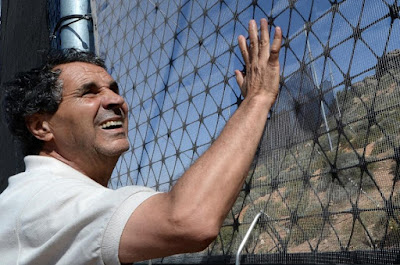Yahoo – AFP,
Zakaria Choukrallah, 19 June 2015
 |
A Moroccan
inspects fog fences in a hamlet on the outskirts of the southern
coastal city
of Sidi Ifni, on June 7, 2015 (AFP Photo/Fadel Senna)
|
Sidi Ifni
(Morocco) (AFP) - Green technology to turn fog into fresh water straight from
the tap has put an end to exhausting daily treks to distant wells by village
women in southwest Morocco.
Families in
five highland Berber communities have begun to benefit from "fog
harvesting", a technique devised in Chile two decades ago and since taken
up in countries from Peru to Namibia and South Africa.
On the
summit of a mountain named Boutmezguida, which looms over the villages at 1,225
metres (4,019 feet), thick fog shrouds about 40 finely meshed panels designed
to trap water and relay it to a network of pipes.
 |
A Moroccan
woman uses water collected
on fog fences to wash her hands in a
hamlet on the
outskirts of the southern
coastal city of Sidi Ifni, on June 7, 2015
(AFP
Photo/Fadel Senna)
|
DSH prides
itself on building "the world's largest fog-collection and distribution
system" and helping locals in the Sidi Ifni region -- Derhem's birthplace
-- to learn to operate it, after repeated droughts and scarce rain.
"Our
rain here is the fog," Derhem adds.
Tiny
droplets are caught on the mesh while fog wafts through panels. The harvesters
mix all they catch with more water derived from drilling, then supply the
villages on the lower slopes.
Derhem
first heard about fog harvesting 20 years ago. A few years later on returning
to Sidi Ifni, he realised that the local climate was similar to that of the Andes
in South America.
DSH joined
forces with Fog Quest, a Canadian charity whose volunteers work in a range of
developing countries. North Africa's first pilot project became operational
after almost a decade's work refining techniques.
'An
imitation of nature'
The valves
were opened at Sidi Ifni for the first time to mark World Water Day, March 22.
Ever since, "92 households, or nearly 400 people," have enjoyed
running water at home, says Mounir Abbar, the project's technical manager.
"Morocco
has a lot of fog because of three phenomena: the presence of an anticyclone
from the Azores (north Atlantic islands), a cold air current and a mountainous
obstacle," Derhem says.
The mesh
that traps water is "merely an imitation of nature," he adds,
pointing out how spiders have always caught minute droplets of water in their
webs.
"This
is ecological and enables us to look after the regional water table, which we
have been emptying away," Derhem says.
The scheme
will be extended to other villages and, in time, advocates hope, to other parts
of the country.
In the
village of Douar Id Achour, residents are proud of their new taps, for good
reason. Women and children used to spend an average of four hours a day on a
round trip to a well, even longer in dry summer.
"I
filled two 20-litre (5.3-gallon) containers four times a day," says
Massouda Boukhalfa, 47. "But even those 160 litres wasn't enough for us,
because we have cattle as well."
'Ready
for export'
During
droughts, water was carried in by tanker trunk. "That took a fortnight and
cost 150 dirhams (13.7 euros), $15.6) for 5,000 litres on average," young
resident Houcine Soussane recalls.
According
to Dar Si Hmad, 7,000 litres of fog water cost three times less than before,
even with a fee of 20 dirhams to each household for the right to a counter.
 |
Thick fog
is trapped by finely meshed panels and relayed it to a network of pipes
(AFP
Photo/Fadel Senna)
|
Villagers
today have more time to collect the nutty fruit of argan trees and extract its
prized and potentially lucrative oil, used in cooking, skin care and easing
arthritis. Reputed as an anti-ageing product, argan oil has been taken up
abroad as an ingredient in high-end cosmetics.
"Our
women and daughters no longer wear themselves out. They go to school and are
safe," 54 year-old villager Lahcen Hammou Ali sums up. "With the time
saved, we can pay for water all year by producing a bottle of argan oil."
DSH next
wants to supply fog water to as many villages as possible in the area. It also
plans to replace mesh in the panels with a new variety that can resist wind
speeds of 120 kilometres per hour (75 mph).
The panels
were perfected on Moroccan soil with help from the German charity
Wasserstiftung, and successfully passed the testing phase.
"The
nets are now ready for export to other towns in Morocco, in all the mountainous
regions and along the seafront," Derham says, hopeful they can be deployed
in all highland areas where fogbanks are frequent.
Related Article:


No comments:
Post a Comment